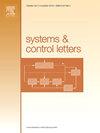Prescribed-time synchronization for multiweighted complex networks: A switching control scheme
IF 2.5
3区 计算机科学
Q3 AUTOMATION & CONTROL SYSTEMS
引用次数: 0
Abstract
This letter deals with an interesting intersection phenomenon of prescribed-time stability (PTSta) for dynamical systems, and develops a novel switching control scheme to investigate prescribed-time synchronization (PTSyn) for multiweighted and directly coupled complex networks. Different from most previous works that scholars only pay attention to designing the regulation function to ensure PTSta, we aim to select various parameters and uncover the mathematical mechanism of intersecting system state curves. We rigorously prove that, if the settling time is larger than 1, then no matter what the initial value is, the intersection exists only once before the settling time; otherwise, there is no intersection. Moreover, an energy consumption evaluation function is also put forward for PTSta, whose exact value is also calculated via exponential integrals. Then, this intersection theory is applied on the PTSyn of multiweighted complex networks, which is beneficial to construct the switching control scheme or choose the optimal parameters to reduce the energy cost. The rearranging variables’ order technique is utilized to conduct the multiweighted complex networks and obtain the synchronization criterion. Finally, four simulations are presented to verify theoretical results.
多加权复杂网络的规定时间同步:一种切换控制方案
本文研究了动态系统的规定时间稳定性(PTSta)的一个有趣的交叉现象,并开发了一种新的切换控制方案来研究多加权和直接耦合复杂网络的规定时间同步(PTSyn)。与以往大多数学者只注重设计调节函数以保证PTSta不同,我们的目标是选择各种参数,揭示系统状态曲线相交的数学机理。我们严格证明了,如果沉降时间大于1,那么无论初始值是多少,在沉降时间之前交集只存在一次;否则,没有交集。此外,还提出了PTSta的能耗评价函数,并通过指数积分计算了PTSta的准确值。然后,将该交叉理论应用于多加权复杂网络的PTSyn,有利于构建切换控制方案或选择最优参数以降低能量成本。利用变量顺序重排技术对多权重复杂网络进行处理,得到同步准则。最后,通过仿真验证了理论结果。
本文章由计算机程序翻译,如有差异,请以英文原文为准。
求助全文
约1分钟内获得全文
求助全文
来源期刊

Systems & Control Letters
工程技术-运筹学与管理科学
CiteScore
4.60
自引率
3.80%
发文量
144
审稿时长
6 months
期刊介绍:
Founded in 1981 by two of the pre-eminent control theorists, Roger Brockett and Jan Willems, Systems & Control Letters is one of the leading journals in the field of control theory. The aim of the journal is to allow dissemination of relatively concise but highly original contributions whose high initial quality enables a relatively rapid review process. All aspects of the fields of systems and control are covered, especially mathematically-oriented and theoretical papers that have a clear relevance to engineering, physical and biological sciences, and even economics. Application-oriented papers with sophisticated and rigorous mathematical elements are also welcome.
 求助内容:
求助内容: 应助结果提醒方式:
应助结果提醒方式:


